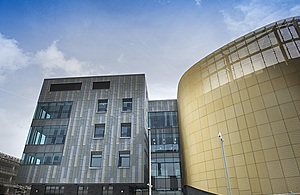
University of Glasgow facility at the Queen Elizabeth Hospital. Photo credit: University of Glasgow
Funded by the UK Government, the Lighthouse Laboratory in Glasgow is part of what will be the biggest network of diagnostic testing facilities in British history, alongside other Lighthouse Lab sites in Milton Keynes and Alderley Park. All have been opened in in recent days.
The newly operational lab will test samples from the regional centres where NHS staff and frontline workers with suspected COVID-19 infections are tested. It is hoped the lab will quickly move towards processing several thousand tests per day, before scaling up further to tens of thousands of tests per day.
Scottish Secretary Alister Jack said:
The UK Government has committed to expanding our testing capacity across the UK. The completion of our network with the Lighthouse Lab in Glasgow is a tremendous achievement for all the partners in such challenging circumstances and only five weeks after this project was started.
Scotland has world-class universities and I am pleased they have been involved in this UK-wide effort as we work together to protect the NHS and save lives. Dr Jodie Hay, a Chronic Lymphocytic Leukaemia researcher at the University of Glasgow, is one of the volunteers at The Lighthouse Lab in Glasgow. A cancer scientist with experience of working with patient samples and molecular lab techniques, Dr Hay volunteered so she could use her skills to help with COVID-19 response in the UK.
The Lighthouse Lab in Glasgow is hosted by the University of Glasgow at the Queen Elizabeth University Hospital Campus.
Professor Dame Anna Dominiczak, University of Glasgow Vice Principal and Head of the College of Medical, Veterinary and Life Sciences, who leads the team said:
I am pleased that after weeks of hard work and continued effort by all involved, the University of Glasgow can now deliver the country new, large-scale testing facility, in conjunction with our industry partners and the NHS.
I remain incredibly grateful to all partners and colleagues who have volunteered their time, expertise and skills for this testing facility. As a result of their willingness to help, we have equipped, staffed and set-up a new testing facility that is now operational and will be vitally important in the NHS efforts against this coronavirus pandemic. It has been said all over the world and confirmed by the WHO that we have to test, test and test more to fight the virus that has killed so many.
The Glasgow facility will be staffed on a 24/7 basis by around 100 staff members. More than 800 volunteers came forward to help with the facility, including highly experiences molecular scientists, technicians and bioinformaticians - all with the relevant skills and experience to carry out COVID-19 testing.
Dr Hay said:
I was one of the first volunteers selected to begin working in the Lighthouse Lab in Glasgow and it has been incredible to see how quickly everyone has been able to get this lab up and running so that we can begin processing the testing samples.
Like my other colleagues working in the lab, we volunteered so that we could use the skills and expertise we have from our usual lab work in this response against COVID-19. Although these are challenging times, it feels positive to be able to use my skills and experience in this way and to be able to help.
The facility has been made possible through the work and commitment of partners, volunteers and University of Glasgow staff, including lab technicians, IT services and colleagues from the Professional Services across the College of Medical, Veterinary and Life Sciences in Glasgow.






